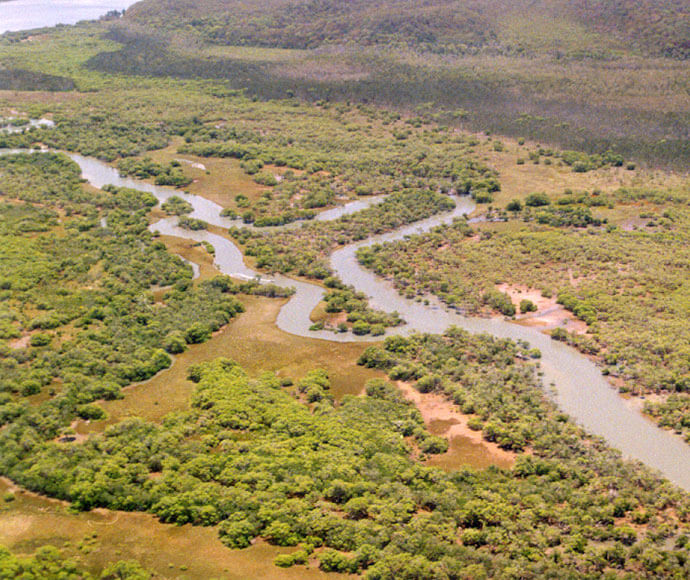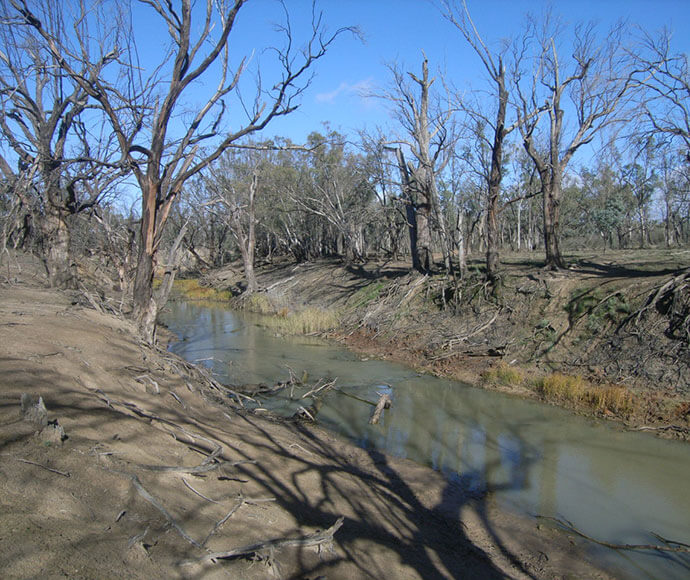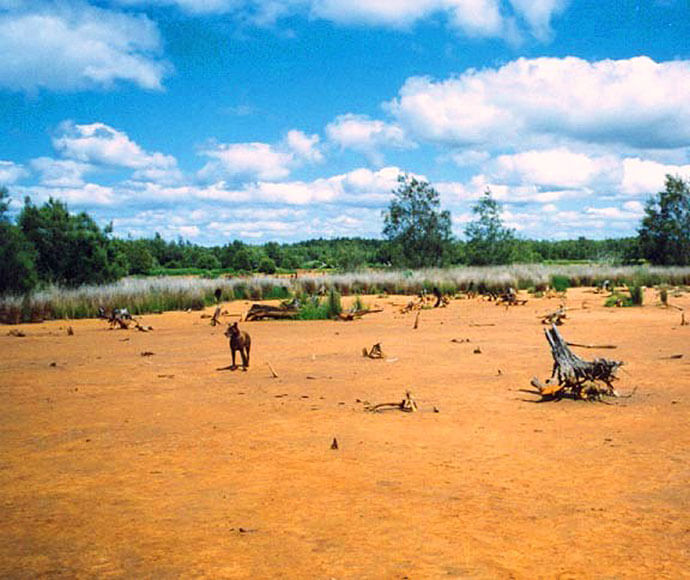Impacts
Acid sulfate soils are common along the NSW coast. Left undisturbed, they do not present any risk. But when acid sulfate soils are exposed to air, the iron sulfides they contain react with oxygen to create sulfuric acid.
The acid makes metals in the soil, such as iron and aluminium, more soluble. These metals can be released in toxic amounts. The acid and released metals can have many damaging effects:
- Damaging waterways and killing aquatic life –Rainfall can wash acid and toxic metals into waterways, killing organisms that are immobile (such as oysters) or that live in sediment. It can also reduce survival and growth rates of plants and animals, and promote outbreaks of disease (especially red-spot disease in fish).
- Killing plants –Very acidic soil can kill all plants growing in it.
- Corrosion –Sulfuric acid can corrode concrete, iron, steel and some aluminium alloys.
- Toxic water and dust –Acid sulfate soil and water can irritate your skin and eyes. Drinking acidic water may make animals ill.
Acid sulfate soils have economic impacts on most industries on the NSW coast, including:
- recreational fishing
- commercial fishing
- oyster growing and other aquaculture
- cropping
- grazing
- dairying.
Causes
Most of the current problems with acid sulfate soils in New South Wales have arisen from past practices in drainage and flood mitigation. Major drainage works were built on floodplains from the Tweed to the Shoalhaven Rivers from the late 1800s until the mid-1970s.
Drainage and excavation of acid sulfate soils remains a current issue for urban development, infrastructure and sand mining.
Coastal locations
Acid sulfate soils are found in every coastal estuary in New South Wales. Because of their estuarine origin, they are usually found at elevations less than one metre above sea level.
Acid sulfate soils are common in mangrove and saltmarsh areas. They underlie floodplains, levees and backswamps.
Acid sulfate soils may affect more than 260,000 hectares of land. About 150,000 hectares of this land are in agricultural production.
The largest areas are the coastal floodplains of northern New South Wales, particularly those of the Tweed, Richmond, Clarence, Macleay and Hastings rivers. Other notable locations include the Hunter and Shoalhaven rivers.
Inland locations
Inland acid sulfate soils occur on inland waterways, wetlands and drainage channels. Like their coastal cousins, inland acid sulfate soils develop in waterlogged, saline and anaerobic (which means 'living without air') conditions.
Inland acid sulfate soils became an issue during the drought in the 2000s, also known as the ‘millennium drought’. This long period of drought reduced water levels and exposed acid sulfate material which oxidised and released acid and metals into inland waterways.
The best-known occurrence of inland acid sulfate soils is along the Edward-Wakool River system, which extends into Victoria. These soils also occur in scattered locations throughout inland New South Wales, including the southern tablelands and the Australian Capital Territory.
Inland acid sulfate soils are often associated with salinity sites and many have not been properly identified.
Edward-Wakool project
The NSW Government collaborated with the Murray–Darling Basin Authority, CSIRO and other basin jurisdictions, to investigate inland acid sulfate soils and their distribution. The results were published in Aspects of Quaternary geology, geomorphic history, stratigraphy, soils and hydrogeology in the Edward–Wakool channel system, with particular reference to the distribution of sulfidic channel sediments.
The report identifies the locations and risks of inland acid sulfate soils to rivers and streams in the Murray–Darling Basin. The report is based on landform assessment, extensive fieldwork.
Risk maps
These maps predict the distribution of acid sulfate soils. They are based on landform assessment, extensive fieldwork and laboratory testing. The maps show:
- the chance of acid sulfate soil occurring
- the estimated depth to acid sulfate soil
- environmental risk associated with disturbing the soil
- the landforms on which the soil occurs.
Obtaining and using the maps
To find out about acid sulfate soil risk and chance of occurrence, look up the acid sulfate soil risk map for your area. Acid sulfate risk maps and thematic maps are available on eSPADE.
You can download the 1:25,000 maps that show the risk of acid sulfate soils. The download includes GIS and PDF versions of the maps and guidelines for their use.
Download acid sulfate soil risk maps
Prevention
The following common activities can trigger acid sulfate soils to oxidise and produce acid.
Agriculture
Those involved in agriculture often need to build drainage systems for activities like:
- sugar cane and tea-tree cultivation
- dairying and other grazing
- cropping
- aquaculture.
Building infrastructure
Excavation takes place when:
- building drainage works to manage floods (such as levees and floodgates)
- dredging
- laying utilities (water and sewerage pipes, communication cables)
- building roads and railways.
Construction
Companies must excavate when building:
- housing
- tourist facilities.
Extraction
Industries excavate when extracting sand and gravel. Most of these works require some form of consent or approval. If you intend to carry out such works, contact your local council first. Councils have local environmental plans that specify how acid sulfate soils must be managed.
Treating acid sulfate soils
Recent research has greatly changed our understanding of how to best maintain and improve soil health.
National guidance documents have been produced, dealing with:
- soil sampling and identification
- laboratory methods
- dewatering groundwater
- dredging and dredge spoil management
- management of monosulfidic black oozes (MBOs).
This national guidance supplements but does not replace the NSW Acid Sulfate Soil Manual (1998) (PDF 4.3MB).
The EPA Waste Classification Guidelines (2014) (PDF 298KB) apply to acid sulfate soils that need to be transported and treated offsite.
Managing acid sulfate soils in agricultural landscapes
The Remediation guidelines for coastal floodplains in New South Wales discuss practical and commonly used tools for remediating acid sulfate soils in agricultural landscapes.


